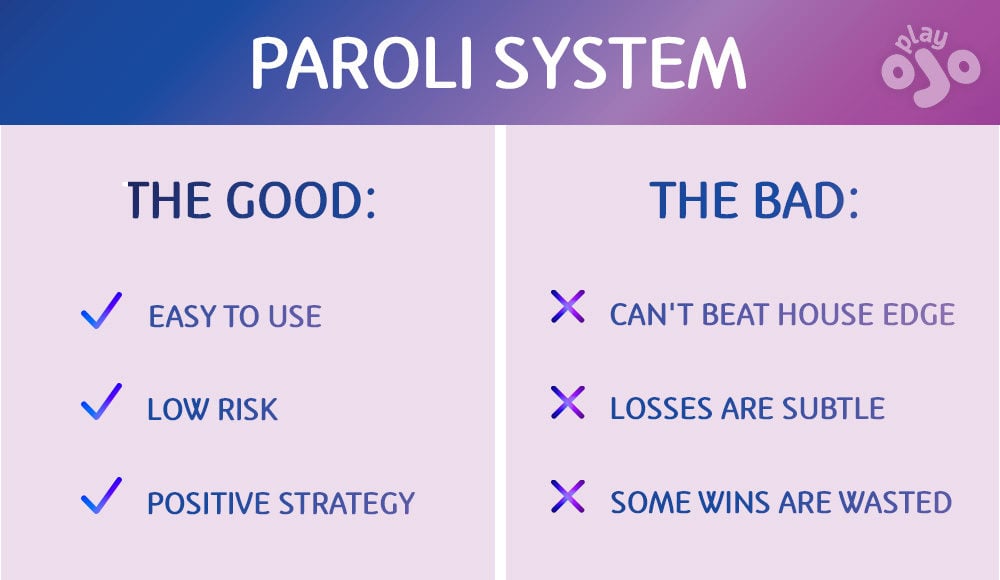The Paroli roulette system and the more famous Martingale system are two sides of the same coin.
In my guide to the Martingale system, I show how it involves lots of small wins and some rare but catastrophic losses.
In contrast to its evil twin, the Paroli system is characterized by lots of small losses and the occasional medium sized win.
You’re about to learn why although this system may look more promising – and it’s certainly less stressful – it’s a losing bet all the same.
A positive progression system
Like many roulette systems, this one came from Europe although it was a relative latecomer, emerging during the turn of the 20th century.
The concept of betting big when you’re winning is in contrast to methods like the d’Alembert system, where you chase losses.
By increasing your bet size only after a win, and capping the amount you can ever bet to 4 units, Paroli’s positive progression bet model aims to deliver medium sized wins while at the same time avoiding the kind of big losses that made Martingale notorious.
The rules of the Paroli betting system

The goal of this system is to win 3 bets in a row in a roulette game. The Paroli method usually involves a bet on red or black.
Here’s a step by step martingale roulette guide to the basics of the system:
- Choose your bet size for 1 unit
- Stake 1 unit on an ‘even money’ roulette bet like red or black
- If it wins, double your bet and repeat until you win 3 in a row
- If it loses, start again with 1 unit
- Once you win 3 in a row, revert to 1 unit (or stop!)
The system in action
Although it’s fairly simple to see how to win, it helps to see how it plays out in practice. Let’s start with the perfect scenario.
The perfect sequence
Let’s look at the ideal start to a roulette session using this positive progression system. Our goal is to hit 3 wins in a row, and we do that immediately. We bet our own £10 at the start and let it ride twice to come away with a £70 profit.
|
Bet |
Stake |
Result |
Running profit |
|
#1 |
£10 |
Win |
£10 |
|
#2 |
£20 |
Win |
£30 |
|
#3 |
£40 |
Win |
£70 |
A more typical example
In this sequence of 10 spins we see a combination of wins and losses, but unfortunately no triple wins. After 5 failed attempts, we do eventually get our shot at the all-important 3-in-a-row in bet #10. Win that and we’d come away £20 in profit, but we lose and end the session £60 down.
|
Bet |
Stake |
Result |
Running profit |
|
#1 |
£10 |
Win |
£10 |
|
#2 |
£20 |
Lose |
-£10 |
|
#3 |
£10 |
Lose |
-£20 |
|
#4 |
£10 |
Win |
-£10 |
|
#5 |
£20 |
Lose |
-£30 |
|
#6 |
£10 |
Lose |
-£40 |
|
#7 |
£10 |
Lose |
-£50 |
|
#8 |
£10 |
Win |
-£40 |
|
#9 |
£20 |
Win |
-£20 |
|
#10 |
£40 |
Lose |
-£60 |
The odds of winning
With a roulette system strategy so heavily reliant on achieving 3 consecutive wins, we should look at the probability of it happening. There’s no need to consider the contrasting odds of losing 3 in a row, as we are flat betting after every loss.

As I did with my Martingale roulette guide, I’ll focus on European roulette rules to calculate the chances of success using this positive progression system.
Whatever even money bet you choose to place, you’ll have 18 numbers out of a possible 37 (36 numbers + the green zero). The odds of winning one bet are 48.6% or 1 in 2.055 times.
The chances of winning 3 bets in a row are therefore 11.5% or 1 in 8.68 times, although the payout is just 7 to 1. That’s the house edge for you.
Pros and cons
I’ve highlighted quite a few advantages of the Paroli betting system, which is unusual as I normally struggle to find any redeeming features with most gambling systems. But with its cautious approach to risk, there are many worse strategies you could try than this simple positive progression system.
There are caveats galore, of course, not least that calling it ‘one of the better roulette systems’ is like saying ‘one of the healthier cigarettes’. But my job is to show you how it works, let you weight up the pros and cons and decide for yourself if it’s worth a spin.

Paroli system: the pros
- Easy to remember: With a flat bet rule for losses and a double-up rule when you win, you can master it in seconds.
- Wide range of applications: You can use it with any even money bet type in roulette, and even if you don’t know how to play roulette, you can use it with most casino games such as blackjack, casino hold’em and baccarat which offer 1 to 1 payout odds.
- Table limits don’t matter: With a max bet of 4 units, you won’t reach the table max bet or need to adjust your bankroll significantly to play.
- No big bankroll needed: Although you will steadily burn through your roulette bankroll if you use it for long periods of time, you don’t need to bring hundreds or even thousands of unit bets to the roulette table.
- No risk of going broke fast: There are no surprises with this strategy and you won’t suddenly find yourself facing a brutal loss (but that doesn’t prevent you going broke slow!)
- Maximizes winning streaks: If you get 3 wins on the trot using the Martingale system, you’ll only win 3 units. With Paroli betting system, you’ll win 7 units.
- Max fun, min risk: If you manage to get 2 wins, you’re in for some fun as you let all of your previous profits and your original stake ride on the final, all-or-nothing parlay: Win 7 units of profit or lose your 4-unit bet and start again at 1 unit.
Paroli system: the cons
- Won’t change the house edge: Whatever way you slice it, the Paroli roulette system does absolutely nothing to negate the house edge. In a European roulette game, for example, you’ll get charged an average of 2.70% on your bets, whether they’re 1, 2 or 4 units.
- Slow bleed disguises the inevitable: If you never lose more than 4 units – and most of the time you’ll lose just 1 unit – then it is easy to ignore the gradual erosion of your stack and come to the conclusion that the Paroli strategy is not a risky proposition. But let’s be clear, unless you stop after a few spins, or you get VERY lucky, the outcome will be the same.
- Wasted profit: You’ll often find that you win 1 or 2 bets and then lose back the next bet of 2 or 4 units, sending you back to square 1 and giving back any profit more quickly than you would with another roulette system. In practice, the disappointment of losing the second double-up is another of the disadvantages of the Paroli betting system.
Does this system work?
You might get lucky in a few spins of the wheel, but the Paroli system isn’t the reliable, profitable strategy that some roulette players think.
Because of the green zero on the roulette wheel, you’re getting worse payout odds than the true probability of a win. This means every bet has a negative expectation, whatever bet size you choose.
The betting model doesn’t make any difference, and although you will occasionally enjoy a 7-unit win, they won’t offset the many 1-unit losses.
The final analysis
The Martingale roulette system uses an unlimited bet size model (unless you’re winning, in which case it’s max 1 unit!). The bet spread of the Paroli system is just 4 units wide, so it’s a much less volatile roulette strategy.
The occasional 7-unit wins are enough to create some excitement however, and the losses are relatively mild, unlike those you see with negative progression models like d’Alembert betting system.
I’m not recommending this system to roulette players as a way to win, as it won’t turn a profit in the long run. But provided you set loss and win limits, and don’t use this (or any) roulette system for too long, the Paroli strategy can be a fun way to play roulette without breaking the bank.


















